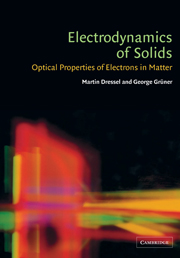Book contents
- Frontmatter
- Contents
- Preface
- 1 Introduction
- PART ONE CONCEPTS AND PROPERTIES
- 2 The interaction of radiation with matter
- 3 General properties of the optical constants
- 4 The medium: correlation and response functions
- 5 Metals
- 6 Semiconductors
- 7 Broken symmetry states of metals
- PART TWO METHODS
- PART THREE EXPERIMENTS
- PART FOUR APPENDICES
- Index
7 - Broken symmetry states of metals
Published online by Cambridge University Press: 20 May 2010
- Frontmatter
- Contents
- Preface
- 1 Introduction
- PART ONE CONCEPTS AND PROPERTIES
- 2 The interaction of radiation with matter
- 3 General properties of the optical constants
- 4 The medium: correlation and response functions
- 5 Metals
- 6 Semiconductors
- 7 Broken symmetry states of metals
- PART TWO METHODS
- PART THREE EXPERIMENTS
- PART FOUR APPENDICES
- Index
Summary
The role of electron–electron and electron–phonon interactions in renormalizing the Fermi-liquid state has been mentioned earlier. These interactions may also lead to a variety of so-called broken symmetry ground states, of which the superconducting ground state is the best known and most studied. The ground states are superpositions of electron–electron or electron–hole pairs all in the same quantum state with total momenta of zero or 2kF; these are the Cooper pairs for the superconducting case. There is an energy gap ∧, the well known BCS gap, introduced by Bardeen, Cooper, and Schrieffer [Bar57], which separates the ground state from the single-particle excitations. The states develop with decreasing temperature as the consequence of a second order phase transition.
After a short review of the various ground states, the collective modes and their response will be discussed. The order parameter is complex and can be written as ∧ exp{iφ}; the phase plays an important role in the electrodynamics of the ground state. Many aspects of the various broken symmetry states are common, but the distinct symmetries also lead to important differences in the optical properties. The absorption induced by an external probe will then be considered; it is usually discussed in terms of the so-called coherence effects, which played an important role in the early confirmation of the BCS theory. Although these effects are in general discussed in relation to the nuclear magnetic relaxation rate and ultrasonic attenuation, the electromagnetic absorption also reflects these coherence features, which are different for the various broken symmetry ground states.
Information
- Type
- Chapter
- Information
- Electrodynamics of SolidsOptical Properties of Electrons in Matter, pp. 173 - 204Publisher: Cambridge University PressPrint publication year: 2002
